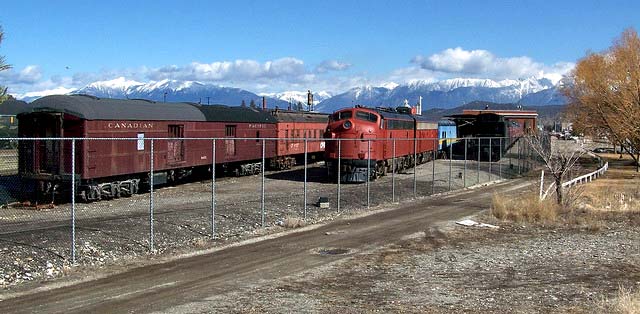
2012
|


Equipment at the Canadian Museum of Rail Travel in Cranbrook - 10 Mar 2010 Gregory Melle.
13 January 2012
Railway Museum Delves Into Archives in New Interpretive Project
Cranbrook British Columbia - Now that the the Cranbrook History Gallery is 95 percent complete and open free to the public, the
Canadian Museum of Rail Travel has turned it's attention to another interpretive project that has been waiting for several years since the new gift shop and
the trains restoration interpretive area was opened in 2008.
The new project involves five large interpretive panels that will provide details on each of the train sets that are on tour. Most people on tours usually have
many detailed questions on the trains that cannot loigistically be included on the audio units. This detailed information is usually beyond the knowledge of
the tour guides, and the 2-hour Grand Tour does not permit the time to go into this level of detail during the tour. The panels will also support the new
school history programs for students of all ages.
The new 4-foot wide by 6-foot high interpretive panels will use poignant images and other textual information so visitors can find out answers on their own
after the tour, or before, if there is a wait time.
The panels will contain early images and promotional material as well as historic printed information including timetables and transcontinental schedules.
Prices will also be an important part of the panels, but are more complicated to determine since the basic first class fare had to add on a supplement for the
type of sleeping space booked. And then there were the incidental daily costs such as snacks, beverages, books, and newspapers, and the many tips that were
expected on the first class trains that the museum displays. These daily costs would be multiplied by the number of days on the trip, which in the case of the
1929 Trans-Canada Limited would have been 3 and a half days from Montreal to Vancouver and return for a total of 7 days of travel. This is something not really
understood today in the age of a few hours of air travel between the same cities.
There will also be an explanation of the services to be found on board these first class trains such as dining cars (with some menus and prices), sleeping
cars, and the lounge cars, including prices for the various sleeping options for the long-distances involved aboard the transcontinental Hotels-on-Wheels.
Specific railway annotated timetables (travelogues) purchased by passengers will detail what passengers would see and referenced by mileage and the various
towns and cities along the routes.
All of this historic material has been collected in the Cranbroook Archives for the past 35 years, including local and national railway history. The two panels
to start the project will be the 1929 Trans Canada Limited, which ran between Montreal and Vancouver on the CPR mainline, and the 1907 Soo-Spokane Train
Deluxe, which ran between Minneapolis and Spokane/Portland through the Crowsnest pass, and Cranbrook. This train was a CPR-SOO line service that was very
important to Cranbrook's early development before World War One, and shows an interesting international view of the CPR and it's intense competition with the
two northern USA railways.
These types of permanent interpretive projects involve large amounts of museum curatorial staff time for research, selecting information, writing additional
text, and designing the layouts prior to large-scale printing in a digital format in Cranbrook. Conceptual work has already been done in the later half of
2011, but now the actual selection of general images and text selection has started so that it can visually fit on the large panels and be relatively easy to
see from 3 feet above the floor to 8 feet above.

|
